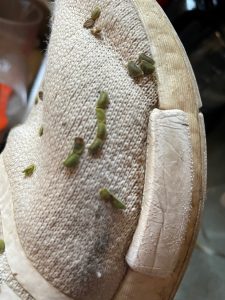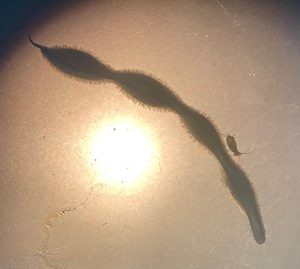
Unable to walk, swim, or fly, plants have developed ingenious ways to reproduce and spread their seeds far and wide. Strategies for seed dispersal may include floating (like the mangrove), wind-driven/airborne movements like the dandelion, or “stickiness.” These sticky seeds may be coated with burrs, spikes, or tiny hooks intended to attach to the fur of passing animals. We humans become unwitting transmitters of plant seed, too. The other day, my daughter walked through a neighbor’s yard and returned home with her shoes covered in something. At first it looked like mud, but I soon realized they were covered in tiny seed pods.

Not wanting to spread the sneaky weeds any further, we pried them all off, collecting them in a small bowl. They had the feel of tiny pieces of Velcro, and would stick tightly to each other or any piece of fabric. Her shoes’ hitchhikers are known as creeping beggarweed (Desmodium incanum), and the plant is extremely successful at attaching to traveling mammals. The structure of the plant is completely built around seed distribution. Like most plants it has leaves and flowers, but hanging off the top are rows of the lightweight and fuzzy seed pods. Their location at the tip of the plant, hanging in multiple directions, positions them perfectly for pickup by traveling wildlife.

The weed—originally from Central and South America but spread widely in the southeastern United States—can also be spread when pieces of a cut or broken stem root into the ground. It’s found frequently in home landscapes, along with pastures, disturbed areas, and commercial property. Mowing turfgrass full of creeping beggarweed after seeds are produced will spread both the seeds and stems, increasing the density of the plant. Specifically labeled herbicides may be used for it, or it can be manually pulled up by the roots.
 3
3
